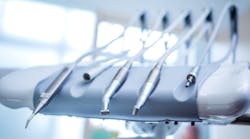Listen to the article on our podcast!
What if one in every three operatories had water that no longer met the standard for safety according to the ADA, FDA, EPA, and CDC? Believe it or not, 31% of treated dental unit waterlines fail to pass the standard for safe drinking water (<500 CFU/mL).1 These operatories are actively treating water, but not testing. Unfortunately, when dental professionals blindly trust that their water is safe without testing, the opportunity to mitigate risk is lost, opening the door to potential outbreaks and infections.
The CDC Health Alert Network (HAN) alert on October 31, 2022, for example, was not due to complete negligence by the dental office—they were treating their water with tablets. 2 However, testing revealed bacteria counts exceeding the standard for safe drinking water.
A whistleblower in Richmond contacted Virginia Department of Health professionals on January 17, 2018, with information regarding negligence on waterline maintenance practices in their office.3 Tests revealed bacteria counts 13 times higher than the 500 CFU/mL standard.
The Anaheim, California, outbreak in 2016 was similar, with over 200 filed lawsuits and 71 documented instances of Mycobacterium abscessus, the Orange County Health Care Agency (OCHCA) and California Department of Health discovered the office had neglected to test and verify that their water was safe.4
These stories are meant to evoke concern. They affect real patients who have had their lives severely impacted due to neglect.
Waterline maintenance must be a priority. Dental professionals cannot continue to neglect this area of infection control. We cannot continue to avoid testing until it is enforced by a legal body. Implement a safe water protocol in your practice and ensure that the water used in nonsurgical procedures meets the highest quality standards.
The 3-step safe water protocol
Shocking involves using a strong chemical or disinfectant to kill and remove the bacteria and biofilm that has built up in waterlines.
Treating adds a low-level antimicrobial to your daily water use. After shocking, a tablet or straw will help keep your waterlines clean until it is time to shock again.
Testing can be intimidating, but don’t let the fear of the unknown hold you back. Even if you get failing test results, it’s OK. At least you know where to start and how aggressive you need to be in remediation. Testing is the only way to verify that your safe water protocol is working and prove that your dental water is safe for patients.
Implementing a safe water protocol doesn’t need to be difficult. There are incredible resources out there to help you get started and be effective. I highly recommend reaching out to my friends at ProEdge Dental Water Labs; this is their focus, and they are excellent at helping dental practices become successful. You can reach them at proedgedental.com or (888) 843-3343.
Editor’s note: This article appeared in the June 2024 print edition of RDH magazine. Dental hygienists in North America are eligible for a complimentary print subscription. Sign up here.
References
- Dewhirst N, Molinari JA. Treating and monitoring dental water. Compendium of Continuing Education in Dentistry. March 2023. https://cdeworld.com/courses/22748-treating-and-monitoring-dental-water
- Outbreaks of nontuberculous Mycobacteria infections highlight importance of maintaining and monitoring dental waterlines. CDC. October 31, 2022. https://emergency.cdc.gov/han/2022/han00478.asp
- Whistleblower claims Virginia pediatric dental office did not properly sanitize equipment, water lines. 3WTKR. January 17, 2018. https://www.wtkr.com/2018/01/17/whistleblower-claims-virginia-pediatric-dental-office-did-not-properly-sanitize-equipment-water-lines
- Singh J, O’Donnell K, Ashouri N, et al. 926. Outbreak of Invasive Nontuberculous Mycobacterium (NTM) Infections Associated With a Pediatric Dental Practice. Open Forum Infect Dis. 2018;5(Suppl 1):S29. Published 2018 Nov 26. doi:10.1093/ofid/ofy209.067








